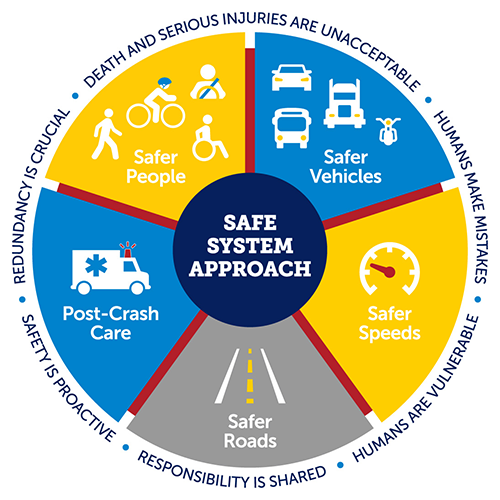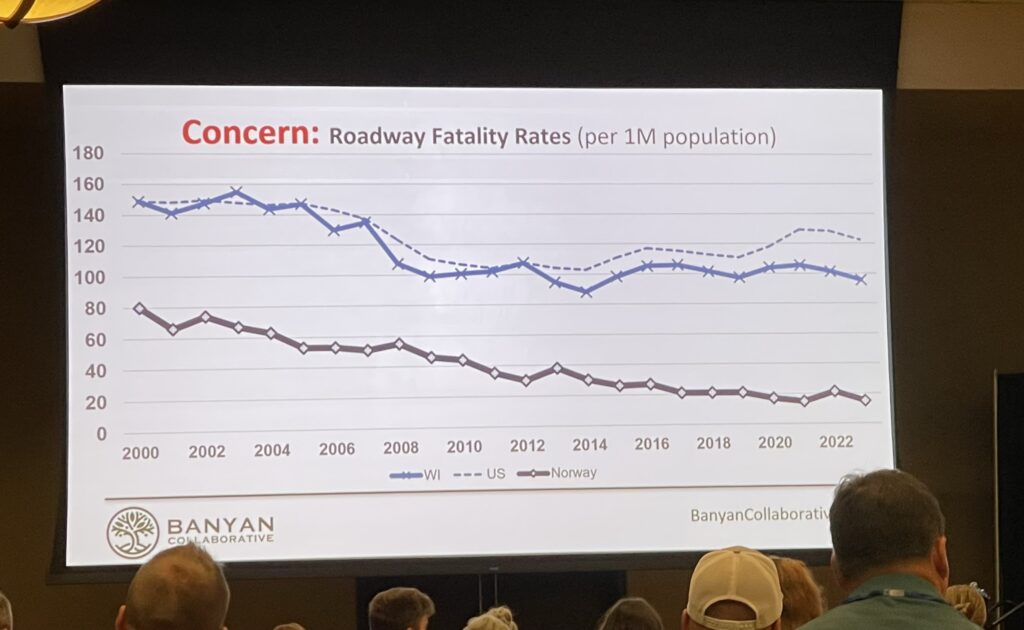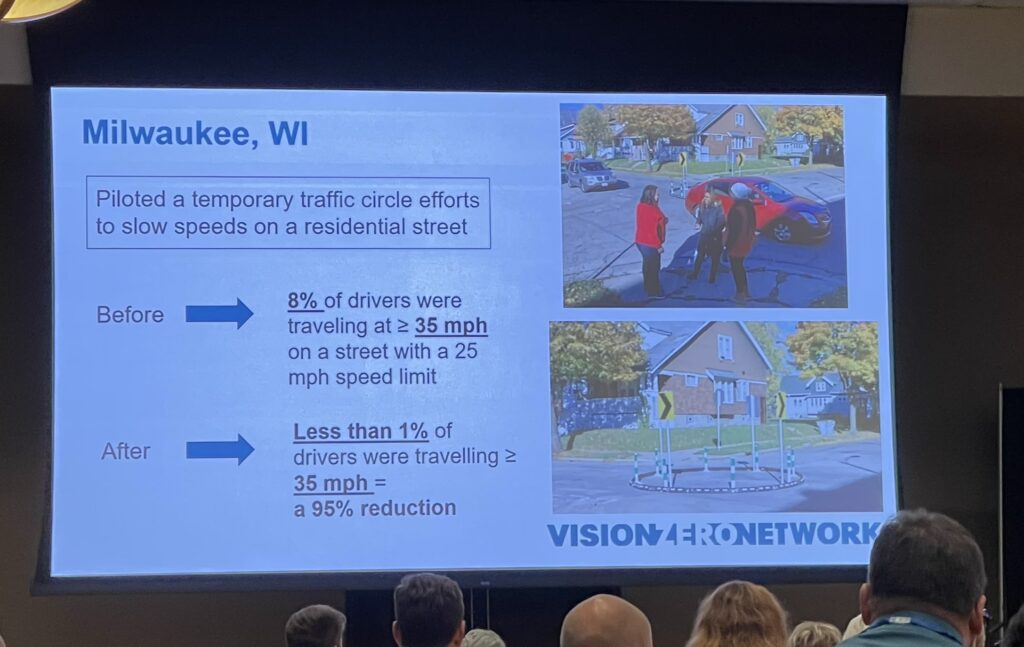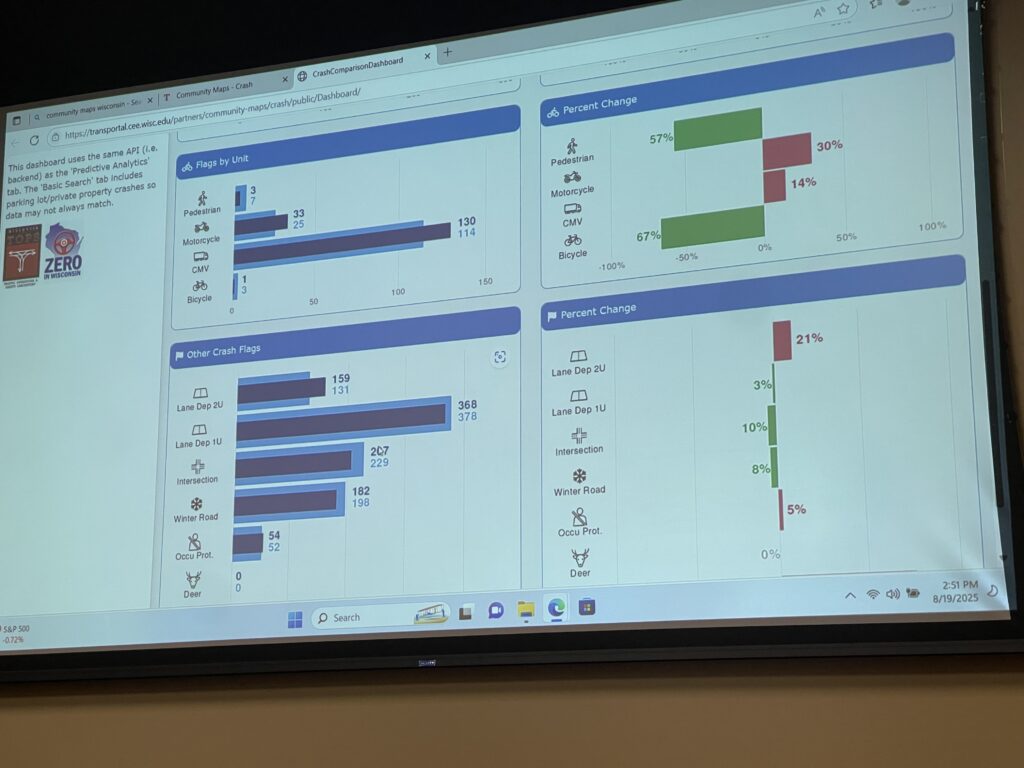This summer MilWALKee Walks sent three staff members to the Wisconsin Governor’s Conference on Highway Safety. Henry, one of our summer Ambassadors, summed up his experience and thoughts on the conference. Enjoy!
On August 19th and 20th, I attended the 50th annual Wisconsin Governors’ Conference on Highway Safety in the Wisconsin Dells on behalf of MilWALKee Walks and the Wisconsin Bike Fed. This was my first time attending, and I had heard that in previous years the primary focus was on preventing traffic crashes through law enforcement rather than through elements such as safer road design, and education. While enforcement is one useful tool for preventing traffic crashes, I was curious how devoted a conference could be to just one of the many aspects of road safety.
The first morning of the conference, I stepped into the main hall before the opening speaker to see which organizations were present. I saw large organizations we have worked with on pedestrian safety, such as AARP, as well as those aimed towards law enforcement, like a manufacturer of speed radars for police cruisers. I was also happy to see that the Vision Zero Network had a presence there. I had my list of breakout sessions that I was ready to attend, being particularly excited for “Advancing Vision Zero in Your Community.” I was thinking this might be one of the only moments with an emphasis on systems and infrastructure in an otherwise enforcement-heavy conference, but was happy to be immediately proven wrong.
As I sat down with my morning coffee to listen to the opening speaker (Jay Otto of Banyan Collaborative) I was glad to hear him talking about the need for a Safe System Approach to traffic safety rather than solely an individual approach. The distinction is that a Safe System approach creates a safe driving system in which driver mistakes are planned for, whereas an individual approach targets individuals who drive recklessly in an unsafe system. In regards to enforcement, he brought up the huge effectiveness shown by camera-enforced speed limit programs around the world (studies have shown that average speeds in camera zones have reduced as much as 25%, and speeding infractions by 90%1).

He presented Norway’s much lower crash numbers in comparison to the United States’ (a real-world comparison like this shows that less traffic deaths are in fact possible. Interestingly, he also called for a show of hands to see which professionals were in the room, and it seemed about 75% law enforcement, trailed by maybe 15% engineers, and a sparse amount of advocates, planners, and public health professionals.

Photo by Henry Barbee
To my delight, the next speaker turned out to be the Vision Zero Network Founder and Executive Producer, Leah Shahum. She gave the crowd a brief primer on the concept of Vision Zero as well as highlighting successes within the U.S. and Wisconsin. Specifically, she mentioned that Milwaukee is a leader in implementing traffic circles (smaller roundabouts at less busy intersections), and is setting an example in traffic calming for the rest of the state.

Leah also mentioned the effectiveness of intelligent speed assistance in vehicles (this is like cruise control, except the speed limit [not the driver] keeps the car from speeding via GPS). I heard some skeptical grumblings over some of the concepts that Leah and Jay presented from the crowd, but they generally seemed to go over well. I was excited to see both opening speakers identify the need for a system approach, and bring that message to an enforcement audience. While enforcement is an important piece of the traffic safety puzzle, it is just one of many, and it is good to show everyone involved how they fit into the larger picture.
The first-day breakout sessions included topics such as drug trends in Wisconsin, current approaches to e-vehicle fires, judges recounting what must be proven in an OWI case, how to build resilience after responding to traumatic highway incidents, and how to advance Vision Zero in your community. Out of the 15 sessions, at least four seemed to have a focus on Vision Zero and a Safe System approach. I opted for a seminar about how traffic engineers use data from on-site crash reports to drive their infrastructure decisions, as well as a seminar walking through advanced features of the Community Maps program. The sessions gave me new insights and knowledge of tools I will likely use in the future, so it was a productive day.

On the second day, we had another spread of safety-related seminars to choose from: another about Wisconsin’s OWI Laws (this time comparing our laws to other states’), teen driver safety, ATV route ordinances, partnerships between tribal nations and traffic safety organizations, and assessing your own organization’s safety culture. Of the 10 sessions, I would say three of them included some kind of Vision Zero or Safe System approach beyond enforcement. I chose “Advancing Vision Zero in Your Community,” and “Assessing Your Organization’s Safety Culture” (presented by the keynote speakers, Leah Shehaum and Jay Otto, respectively). Both seminars included absorbing and thoughtful discussions about possibilities to improve our own organizations’ and communities’ ways of approaching traffic safety.
After the days’ sessions came the conference’s closing remarks. A call was made by some of the speakers (including a victim of an impaired driving crash) for more severe punishments for driving under the influence, in order to prevent future accidents. While I appreciated these speakers trying to find ways to reduce these tragic crashes, I am not sure how effective this would be. I know that research increasingly shows that not only do harsher penalties fail to deter crime, they generally increase the chances of re-offense2. A more effective way to create Safer People (one of the five elements of the Safe System approach) could be to expand programs such as Saferide, which gives impaired people in Wisconsin a free ride home. Expanding public transit access could also help in this regard.
Lastly, an awards ceremony honored officers for the amount of impaired driver arrests they had made during the previous year, and over their careers. It was a relief to see the number of under-the-influence drivers that each officer had taken off the street, as each one of those impaired trips could have ended with a life-changing injury or death. As I rode the train home with my fellow MilWALKee Walks colleagues, I was glad that the Governor’s Conference seems to be making a real effort to include advocates for Vision Zero and a Safe System approach into the conversation. While enforcement is an important part of a Safe System, working together and understanding the roles that other professionals play— including engineers, bar owners, hospital workers, and so many others– is the only way to truly reach zero traffic deaths in our communities. I came away from this conference clearer than ever about that.
- SSTI. (2024, March 11). Speed cameras lower speeds and prevent crashes — New research confirms. Retrieved September 15, 2025, from https://ssti.us/2024/03/11/speed-cameras-lower-speeds-and-prevent-crashes-new-research-confirms/ ↩︎
- Knight, B. (2020, July 15). Do harsher punishments deter crime? UNSW Sydney Newsroom. https://www.unsw.edu.au/newsroom/news/2020/07/do-harsher-punishments-deter-crime ↩︎